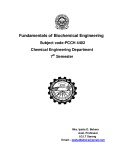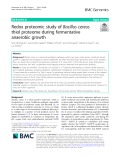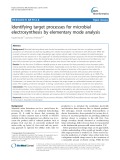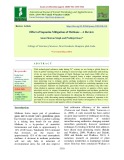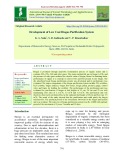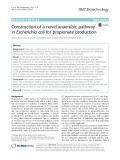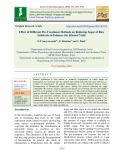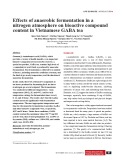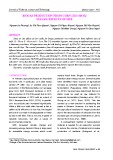
Anaerobic fermentation
-
Part 1 book "Basic medical microbiology" includes content: Overview of medical microbiology, introduction to bacteria; aerobic gram positive cocci; aerobic gram positive rods; acid fast bacteria; aerobic gram negative cocci and coccobacilli; aerobic fermentative gram negative rods; aerobic nonfermentative gram negative rods; anaerobic bacteria, spiral shaped bacteria; intracellular bacteria,... and other contents.
 136p
136p  oursky07
oursky07
 24-10-2023
24-10-2023
 5
5
 2
2
 Download
Download
-
Lecture Solid waste management - Chapter 6: Anaerobic digestion/biogasification (CE 43) provide students with knowledge about biogasification, biogas generation, fermentation, methane fermentation and methane production.
 7p
7p  huangminghao_1902
huangminghao_1902
 27-02-2022
27-02-2022
 14
14
 1
1
 Download
Download
-
Lecture Fundamentals of Biochemical engineering. After completing this section, you will understand knowledge about: overview of microbiology, Aerobic & Anaerobic fermentation processes, fermenter design, sterilization of microbial medium, kinetics of microbial growth, enzymes and its kinetics, immobilization of enzymes, chemostats. Transport phenomena in Biochemical Engineering, Heat and Mass transfer in Bioprocessing, oxygen transfer in fermenter, monitoring and control of fermentation process...
 125p
125p  bachkhinhdaluu
bachkhinhdaluu
 03-12-2021
03-12-2021
 11
11
 1
1
 Download
Download
-
There is a worldwide interest for sustainable and environmentally-friendly ways to produce fuels and chemicals from renewable resources. Among them, the production of acetone, butanol and ethanol (ABE) or Isopropanol, Butanol and Ethanol (IBE) by anaerobic fermentation has already a long industrial history. Isopropanol has recently received a specific interest and the best studied natural isopropanol producer is C. beijerinckii DSM 6423 (NRRL B-593).
 12p
12p  vibeauty
vibeauty
 23-10-2021
23-10-2021
 5
5
 0
0
 Download
Download
-
Lecture Principles of Biology - Chapter 9: How Cells Harvest Energy. After completing this section, you will understand the knowledge about general pathways for making atp, aerobic respiration, anaerobic respiration, fermentation,...
 47p
47p  bachtudu
bachtudu
 30-09-2021
30-09-2021
 8
8
 1
1
 Download
Download
-
Bacillus cereus is a notorious foodborne pathogen, which can grow under anoxic conditions. Anoxic growth is supported by endogenous redox metabolism, for which the thiol redox proteome serves as an interface. Here, we studied the cysteine (Cys) proteome dynamics of B. cereus ATCC 14579 cells grown under fermentative anoxic conditions. We used a quantitative thiol trapping method combined with proteomics profiling.
 15p
15p  vitzuyu2711
vitzuyu2711
 29-09-2021
29-09-2021
 7
7
 0
0
 Download
Download
-
In wine fermentation starter cultures, the blending of non-Saccharomyces yeast with Saccharomyces cerevisiae to improve the complexity of wine has become common practice, but data regarding the impact of co-cultivation on yeast physiology and on genetic and metabolic regulation remain limited.
 15p
15p  visilicon2711
visilicon2711
 20-08-2021
20-08-2021
 9
9
 1
1
 Download
Download
-
The aim of this study was to evaluate the performance of an autotrophic denitrification during an anaerobic fermentation process usingH2/CO2 mixture gas (80:20, v/v) as sole energy source. Chemostat reactors were operated with anaerobically acclimated hydrogenotrophic methanogens culture broth.
 5p
5p  cothumenhmong9
cothumenhmong9
 18-01-2021
18-01-2021
 10
10
 2
2
 Download
Download
-
The main contents of this chapter include all of the following: Cellular respiration: aerobic harvesting of energy, stages of cellular respiration, fermentation: anaerobic harvesting of energy, connections between metabolic pathways.
 80p
80p  tradaviahe14
tradaviahe14
 27-01-2021
27-01-2021
 25
25
 2
2
 Download
Download
-
Microbial electrosynthesis and electro fermentation are techniques that aim to optimize microbial production of chemicals and fuels by regulating the cellular redox balance via interaction with electrodes. While the concept is known for decades major knowledge gaps remain, which make it hard to evaluate its biotechnological potential.
 14p
14p  vikentucky2711
vikentucky2711
 26-11-2020
26-11-2020
 9
9
 0
0
 Download
Download
-
Farmed ruminants form a very large portion of total anthropogenic methane emissions globally. Methanogens present in ruminal flora primarily uses Hydrogen [H] produced during anaerobic carbohydrate fermentation. Ruminal microflora can convert plant fiber unavailable for humans into microbial protein available for absorption for ruminants with biological value 70.
 15p
15p  nguaconbaynhay7
nguaconbaynhay7
 15-08-2020
15-08-2020
 15
15
 2
2
 Download
Download
-
Biogas is produced through anaerobic fermentation process of organic matter and it contains CH4, CO2, H2S and other gases. The main combustible gas in biogas is CH4 and the presence of other gases reduces the calorific value of biogas, hence for obtaining better performance of engine it is essential to remove CO2 and H2S present in raw biogas. The dry absorbent based biogas purification system was developed and its performance was evaluated.
 6p
6p  angicungduoc6
angicungduoc6
 22-07-2020
22-07-2020
 9
9
 1
1
 Download
Download
-
Butanol is a virtually promising bio fuel of our future imputing to its higher blending ratios in petrol and diesel without any retrofitting in IC engines. Biobutanol was produced from Acetone Butanol and Ethanol (ABE) fermentation of 5% ortho phosphoric acid pretreated paddy straw biomass using Clostridium acetobutylicum ATCC 824 strain. ABE fermentation was a zymolysis process of Clostridium bacteria, the anaerobic breakdown of sugars into alcohols in which the solvents formed were a result of two different phases of acidogenesis and solventogenesis.
 8p
8p  angicungduoc6
angicungduoc6
 20-07-2020
20-07-2020
 17
17
 1
1
 Download
Download
-
Propionate is widely used as an important preservative and important chemical intermediate for synthesis of cellulose fibers, herbicides, perfumes and pharmaceuticals. Biosynthetic propionate has mainly been produced by Propionibacterium, which has various limitations for industrial application.
 9p
9p  vihamax2711
vihamax2711
 21-04-2020
21-04-2020
 10
10
 1
1
 Download
Download
-
Ethanol production is also known as ethanolic fermentation in which sugars of biomaterials are converted into the ethanol and carbon hydroxide that may called as coproduct of fermentation. In general fermentation is a bio-chemical process where decomposition of biomaterials takes place. During bio-chemical reduction the sugar compounds like sucrose, fructose, glucose and lactose are converted into the ethyl ethanol and CO2 as by product of the fermentation process.
 19p
19p  quenchua4
quenchua4
 06-04-2020
06-04-2020
 15
15
 3
3
 Download
Download
-
This research work aimed at obtaining a novel natural food product from pollen, safe and improved nutritional value, to be used as a dietary supplement or a functional ingredient for formulating other foods. Bee-collected pollen subjected to lactic acid fermentation using lactic acid bacteria Lactobacillus lactis and its effect on some of the natural characteristics of the pollen were studied.
 7p
7p  nguathienthan2
nguathienthan2
 19-12-2019
19-12-2019
 36
36
 2
2
 Download
Download
-
In this study, the levels of bioactive compounds in tea leaves produced by fermenting fresh tea leaves in nitrogen gas are investigated. The fermentation was conducted at different temperatures: room temperature (28±2), 35, and 40ºC; and for each temperature setting, the fermentation times were 6, 9, 12, and 15 hours. The results show that the GABA content increased significantly with fermentation temperature. The most appropriate temperature and time for the anaerobic fermentation to produce GABA and other bioactive compounds were, respectively, 40ºC and 9 hours.
 5p
5p  caygaocaolon1
caygaocaolon1
 13-11-2019
13-11-2019
 20
20
 1
1
 Download
Download
-
Chapter 6 - How cells harvest chemical energy. The main contents of this chapter include all of the following: Cellular respiration: aerobic harvesting of energy, stages of cellular respiration, fermentation: anaerobic harvesting of energy, connections between metabolic pathways.
 74p
74p  shiwo_ding2
shiwo_ding2
 03-04-2019
03-04-2019
 24
24
 1
1
 Download
Download
-
The preferred order of glucose and fructose uptake by Leuconostoc mesenteroides was investigated in Glucose Fructose Yeast Extract Amino Acid medium with and without the addition of salt under anaerobic conditions.
 6p
6p  aquaman27
aquaman27
 15-01-2019
15-01-2019
 17
17
 1
1
 Download
Download
-
The results show that using corn stalks in size 8 - 10 cm produced more biogas than other sizes. Using corn stalks for biogas production help farmers improve their life conditions.
 7p
7p  vidanh27
vidanh27
 08-12-2018
08-12-2018
 38
38
 1
1
 Download
Download
CHỦ ĐỀ BẠN MUỐN TÌM










